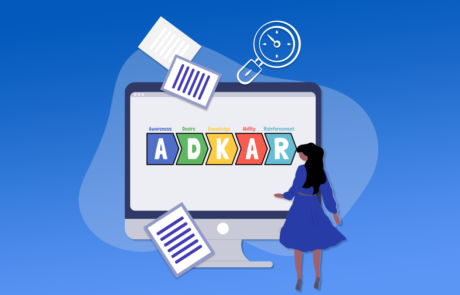Change Management: The ADKAR Model Explained With Examples

How would you feel if your employer called the whole team for a meeting and asserted that all of you will have to follow a new process starting tomorrow?
It’s likely that you’ll feel anger, disgust, sadness, and...basically, all the negative emotions.
And guess what! That’s a normal reaction.
That is why when organizations are trying to implement a new change. The organizations should use a trusted methodology for change management to manage the human side of the management.
In this article, we will discuss the ADKAR model for change management, which is a people-centered framework that allows change leaders to create change in an empathetic way.
1. Awareness
The first stage of the ADKAR change management model, Awareness, refers to communicating the need for a change to employees.
It’s essential that not only the whole team understands the reasons behind introducing a change, but also agrees with the reasons. To do this, leaders should justify the need for change through personal stories instead of PowerPoint presentations and bullet points. Let them know what’s working and what isn’t, and how can the proposed change help the company get back on track.
Also, it’s important to have two-way communication. One should let the employees and stakeholders share their opinions. You don’t want to ‘impose’ a change, you want to ‘implement’ it.
Example
So, how can an organization achieve this? Let’s consider an example. When McDonald’s introduced touch-screen kiosks within their outlets, it enabled customers to place their order without talking to team members. The team worried about their job security. However, thanks to the change leaders’ communication skills and EQ. They implemented the change successfully, and the company still employs humans (not just machines) at their outlets.
2. Desire
The second stage of the ADKAR change management model is Desire. It refers to communicating the benefits of the change to the team and creating a desire to change.
When the team has no desire for change, it may be difficult, if not impossible, to successfully implement a change. No matter, which methodology for change management a company employs to incorporate.
To create a desire for change, change leaders should communicate the benefits of the intended change to employees over and over again. It is also important, at this stage, to listen to the team’s objections and address them. Just make sure they feel heard and included. Studies show that staff members are more likely to respond positively to a change if they are listened to. So, the last thing a change leader should do is rush the change without creating the desire to change first.
Example
Let’s consider an example again. Suppose the marketing team in your company has been using basic CRM software for the past two years. But now, since the business is growing, you have decided to invest in a state-of-the-art CRM platform. Now, the thing is, it will require employees to spend a few extra hours every day for a couple of months to learn how to use it efficiently. At this stage, it is necessary to communicate to the team that not just the company, will benefit from this in the long run. For instance, you could mention that this CRM will enable the business to charge a higher fee from clients, and this higher charge will also result in higher salaries soon.
3. Knowledge
The third stage of the ADKAR change management model, Knowledge, refers to providing the team with the knowledge on how to change.
This is the action stage. Just communicating and answering questions won’t help. We need to take an action at this stage in order to turn the proposed change into a reality. Knowledge needs to be given about the new tools, skills, processes, and job responsibilities. Simply put, we need to teach each employee how they should provide value following the change and where they fit in the entire process.
Example
Let’s discuss a scenario to understand this point better. If you’re switching to Agile, you should hire an Agile coach who can design Agile workflows and help teams learn and utilize them. Whether it’s Scrum or Kanban, Agile methodologies can be tricky to understand initially. And if you are incorporating Agile in your organization, you must give the employees in-depth knowledge of this methodology, otherwise, the change management process could be futile.
4. Ability
The fourth stage of the ADKAR change management model, Ability, refers to using the knowledge that’s acquired from training to execute the change.
Simply having knowledge about a subject doesn’t necessarily mean one can use that knowledge in practical situations. That’s why at this stage, leaders should ensure that employees have grasped the new processes and systems well and can use them efficiently. If there are any barriers that are holding team members back, then they should be identified and addressed. For instance, if the company’s laptops have an outdated OS that doesn’t fully support all features of a new app, it could become a hindrance. So, you should update the OS as soon as possible.
Also, leaders must remember that everyone goes through a different learning curve and some employees may need more time and training than others. That’s why one must strive to create a culture in which asking questions is encouraged and people are not shamed for not knowing something.
Example
Let’s continue with the example that was mentioned in the previous point. Before fully incorporating Agile into the company, change leaders, along with the Agile coach, must conduct test sprints and have weekly meetings to identify how well employees are adapting to the new ways of working. Leaders must also identify and evaluate any barriers and get rid of them. Furthermore, team members who are struggling to apply the Agile methodology in their day-to-day tasks should be offered guidance and support.
5. Reinforcement
The fifth stage of the ADKAR change management model, Reinforcement, refers to sustaining change through celebrating successes and rewarding employees.
It takes a while for a change to become the norm. Until then, change leaders must use reinforcement tactics to preserve the change. During this stage, people must be given a lot of feedback, both positive and constructive, and vigilance must be exercised to ensure that people don’t fall back into old patterns of behavior.
Also, routinely sharing success stories motivates employees to stick to the change and makes them more open to further changes. At this stage, employees who gave a significant contribution towards implementing the change should be recognized and rewarded publicly. This is another way to motivate all the team members to adapt to the change.
Example
Zendesk, a SaaS company headquartered in California, uses the ‘Champagne Campaign’ to motivate its employees. As soon as a sales agent reaches their target number of sales, the sales manager places a champagne bottle at their desk. This example isn't necessarily related to any particular methodology for change management, but it surely is a creative way to publicly reward high achievers and facilitate healthy competition within the company.
So, that was the ADKAR change management model. As a management consultant, it’s likely that you will get to work on a change management project at some point in your career. But remember that a change affects people, and you must understand how it impacts them and what process should be followed to ensure a smooth transition into the new ways of working. To achieve this, make full use of the ADKAR change management model. Better yet, bookmark this article and have a read one more time before you actually initiate the project. You should also stay tuned for the launch of Consultport Academy’s new Change Management Strategy Course - launching later this month.



